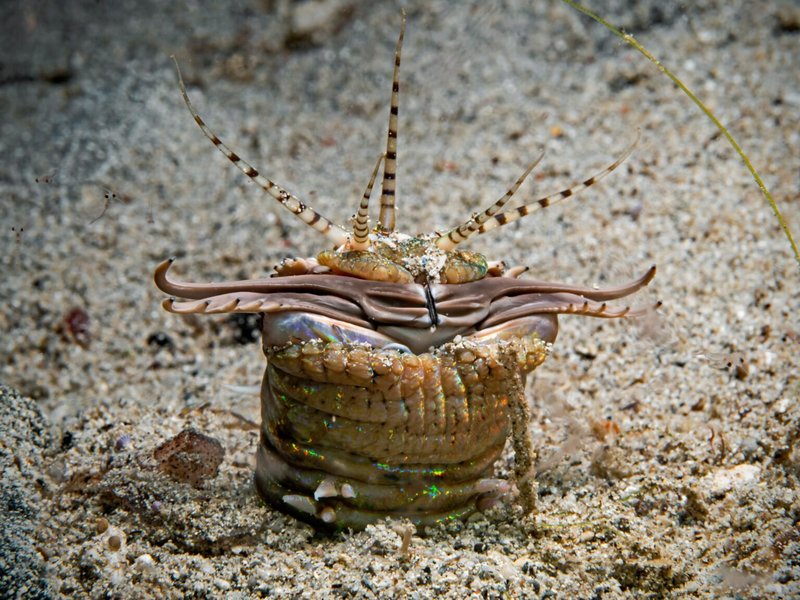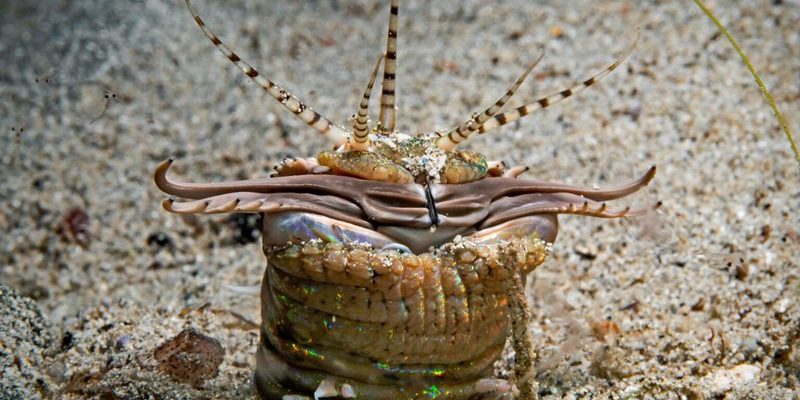
So, what makes the Bobbit worm so fascinating? Let’s dive into its world, exploring its unique sensory perception and how it uses its intelligence to survive—and even hunt—effectively in its dark and often hostile habitat.
What is a Bobbit Worm?
The Bobbit worm, or *Eunice aphroditois*, can be found in tropical and subtropical waters, often buried in sandy or muddy substrates. These remarkable creatures can grow up to 10 feet long, and their long, thin bodies are segmented, resembling a piece of ribbon candy. Their bright colors can range from green to orange to purple, making them as visually striking as they are mysterious.
Despite their beauty, Bobbit worms are known for their predatory nature. They lie in wait, camouflaged against their surroundings, ready to strike unsuspecting prey that swims too close. Think of them as the perfect ambush predators, using their keen senses to hunt effectively in the dim light of the ocean floor.
How Do Bobbit Worms Perceive Their Environment?
One of the most captivating aspects of Bobbit worms is their sensory perception. These worms are equipped with a range of sensory organs that help them navigate their underwater world. Unlike humans, who primarily rely on sight and hearing, Bobbit worms depend on a combination of touch, smell, and even chemical signals to interpret their surroundings.
For instance, they have sensory structures called antennae located on their heads. These antennae are highly developed and are excellent at detecting movement and vibrations in the water. When something swims nearby, the antennae pick up on those vibrations, alerting the worm to potential prey. This ability is crucial for survival, and it shows just how critical perception is for their way of life.
Bobbit Worm Intelligence: Are They Smart?
Intelligence in animals isn’t always about solving puzzles or using tools. In the case of the Bobbit worm, their intelligence lies in their incredible adaptability and problem-solving skills when it comes to hunting. They are opportunistic feeders and will take advantage of various prey, including fish and crustaceans.
When it comes to catching prey, Bobbit worms use their sharp jaws to snap at passing fish with remarkable precision. They can strike with lightning speed, thanks to the combination of their keen sensory perception and natural instinct. This ability to anticipate movements and react quickly demonstrates a level of intelligence that many people may not associate with worms.
The Role of Chemical Sensation
You might be curious about how Bobbit worms use chemical signals to enhance their senses. These creatures can detect chemical cues released by potential prey through their chemoreceptors. This sense is vital—especially in dark waters where visibility is limited.
Imagine walking in a dark room and being unable to see anything. Now think about being able to smell the pizza cooking in the kitchen; that’s similar to what these worms experience. They can sense when other creatures are nearby, even if they can’t see them. This remarkable ability helps them locate food and navigate their environment more effectively.
Communication and Social Behavior
While Bobbit worms are mostly solitary creatures, they still possess some fascinating ways to communicate. When it comes to reproduction, males and females release specific pheromones into the water to attract each other. This chemical communication is their way of saying, “Hey, I’m here, and I’m interested!”
Interestingly, this chemical signal can travel quite a distance, making it easier for mates to find one another in the vast ocean. It’s like sending an underwater invitation to a dance; once you’ve attracted a mate, the next step is crucial for the continuation of the species.
Threats and Adaptations
Like many creatures in the wild, Bobbit worms face threats from predators. Fish, crustaceans, and even other larger marine animals might consider them a meal. To defend themselves, these worms can burrow deeper into the sand, using their long bodies to hide from danger.
Their ability to camouflage within their environment is another fascinating adaptation. The segmented body can mimic the surrounding substrate, making it difficult for predators to spot them. This blend of intelligence and sensory perception allows Bobbit worms to survive in a world filled with dangers.
Why Understanding Bobbit Worms Matters
Studying Bobbit worms and their sensory perception not only satisfies our curiosity but also offers insights into marine ecosystems. These unique creatures are part of the complex food web in the ocean, and understanding their behaviors can help us comprehend how energy flows through these systems.
Additionally, learning about their intelligence and adaptations can inspire us to protect their habitats. The ocean is an intricate environment, and every creature, no matter how small or seemingly insignificant, plays a role. By understanding the Bobbit worm, we start to appreciate the beauty and complexity of marine life.
In conclusion, Bobbit worms may not have the typical intelligence we often think of in animals, but their sensory abilities and problem-solving skills highlight a different kind of smarts. Their unique adaptations allow them to thrive in the depths of the ocean, making them extraordinary creatures worth studying and protecting. The next time you think about intelligence in the animal world, remember that it comes in all shapes and sizes—even in the form of a colorful worm lurking beneath the sand!

